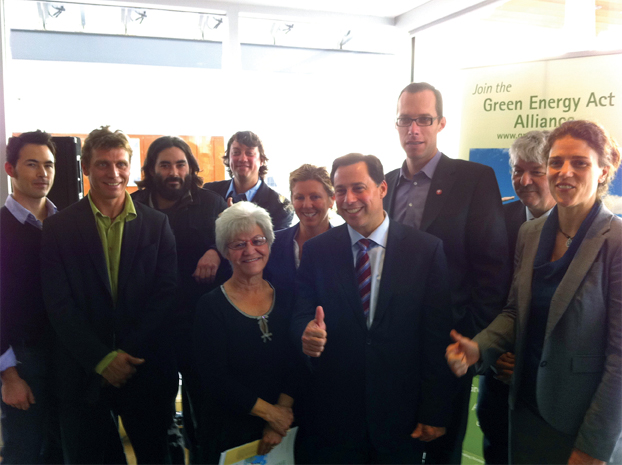Ontario Energy Minister Brad Duguid marked the passage of the Green Energy Act a year and a half ago on November 26 by issuing a directive that would expand the scope of the Community Energy Partnerships Program (CEPP). The expansion was celebrated by the minister and several leaders of the renewable energy industry at a public event at a youth hostel in Toronto. The program provides grants of up to $200,000 toward community-based renewable energy projects in Ontario. The money can be used to fund the development and regulatory approval phases of these projects. The Minister’s directive will now allow co-operatives owned by residents of Ontario to apply for financial assistance of up to $500,000 for project planning costs for projects over 10MW. Additionally, the program will provide funding for education and capacity building activities for renewable energy in the province.

One immediate beneficiary of the announcement is a 20 MW community-owned wind project being developed by the Toronto Renewable Energy Co-operative (TREC), whose first community-owned windfarm can be seen from Lakeshore Drive in Toronto, on its pad at the southwestern end of Exhibition grounds. Judith Lipp, Executive Director at TREC, noted that the location of the planned windfarm is in the Bruce area, currently a region with no available transmission capacity, and so not able to start construction anytime soon. However, the expanded availability of design and approval funding will now allow the project to get started, she said.
The CEPP will also fund educational workshops, webinars and other outreach activities oriented toward the engagement of members of local communities to develop renewable energy projects.
The total budget cap for CEPP each year is $10 million dollars. The directive is effective immediately – the program managers, Community Power Fund (CPF) and Deloitte will begin to work on the program amendments as soon as possible and include the revisions in the published rules.
As of November 29, a total of 33 projects being developed by Ontario-based citizens, energy co-ops and locally owned enterprises have so far been awarded a total of more than $2.45 million to conduct design and development and/or obtain regulatory approvals under the community power provisions of the Green Energy Act.
Speaking of the GEA’s track record, Dr. Rick Smith, Executive Director of Environmental Defence, said “Ontario is a clean energy success story. We’re ahead of where many European leaders were at the same stage of their clean energy transformations.” Key findings in a report by the Green Energy Act Alliance are that Ontario has offered contracts for more wind and solar power than France in the first year of its program, and more solar than Spain in its first year.
The announcement was made at an international youth hostel on Dundas Street, which features both photovoltaics and solar hot water, as well as ground-source space heating, waste water heat recycling, and LED lighting throughout. Energy demand for lighting in the four-story building is about equal to that of a hair dryer.
